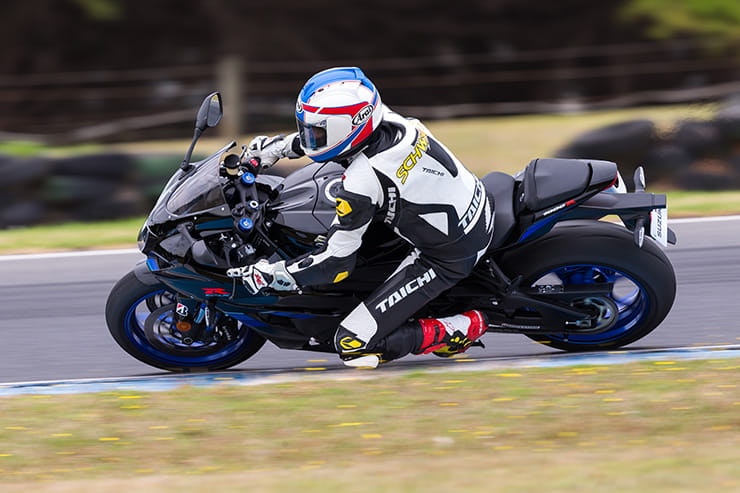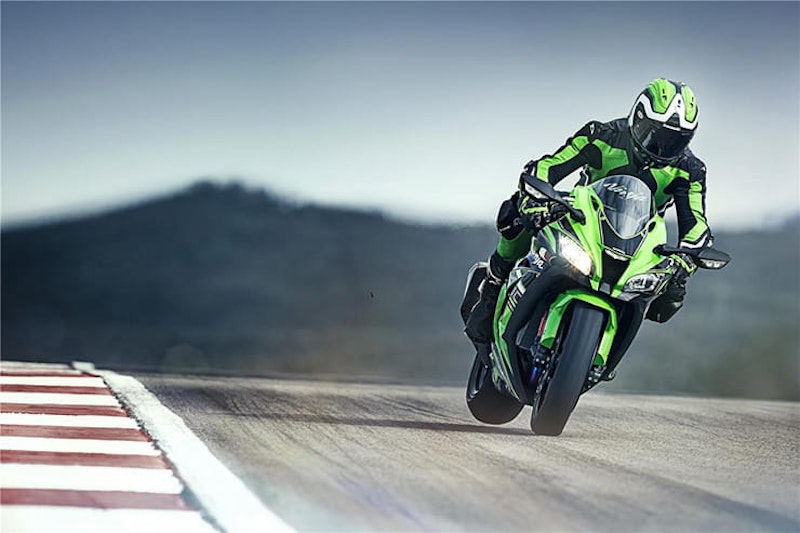Mike Abbott is this month’s instructor. He’s an ex-engineer, successful racer and hugely qualified trainer. He runs the British Superbike School, which has courses at tracks around the country. You can book on 01777 818013
Can I learn anything that has any relevance to road riding?
One of the most important techniques you can improve on track is braking. Most road riders don’t practice their emergency stops, and even if they do it’s usually from low speed. But on track the idea is you do an emergency stop at every corner, so you very quickly get used to that feeling of the back being really light and skipping around, and the bars shaking a little bit as you build up your braking. We’ve had riders come on our track course who never use the front brake, so you can imagine how much their braking improves.
A certain Mr K Schwantz on a track day demonstrating pinpoint accuracy at the apex.
Any other easy wins?
Track riding can help show where the easy speed gains are. Left to their own devices most riders end up rushing into corners faster and leaning the bike over more in an attempt to go faster. But what they don’t realise is that one of the easiest ways to lap faster is to get on the gas earlier so you can carry that advantage all the way down the next straight. Rushing into corners will save a bit of time, but getting on the throttle early will save a lot.
And I presume you learn what your bike is like at speed?
Of course. We had a police rider on one of our track courses this year and it was the first time he’d ridden at a circuit. He was a very good rider, but he said afterwards that he’d never had the opportunity to really feel what the bike was doing because he was used to negotiating his way through hazards and concentrating on them. That’s one of the main advantages of riding on track - you can learn what your bike actually feels like when you go faster, and how to get the most out of it. Even if you go fast on the road you’ll understandably be concentrating more on the lamp-posts and other traffic rather than exactly what the rear suspension is doing.
Learning how to extract the maximum from your brakes is possibly the most useful aspect of track days for road riders
I’m not sure I’d know what to feel for
If you go on a track riding course - rather than an ordinary track day - you can break down your riding under controlled conditions. That can be much more difficult to do on your own on a trackday. On our course, for example, we break down cornering and teach it in reverse order, so you learn how to exit a corner first, then how to find the apex, then where to turn in, and then where to brake.
Why would you do that?
It sounds odd, but you don’t know when to brake if you don’t know what line you should be going in on and you’ve only got a vague idea where the apex is. But if you start off just trying to get the exit to each corner right, it gives you a better idea of where the ideal apex is so you can open the throttle early and keep it open all the way to the exit. On the circuit you can play around with this and experiment to see how you can use most of the track, accelerating as hard as you dare. You need to feel as though you’re drifting out because of the amount of power you’re applying, rather than because you’re just pointing in that direction.
The biggest gains in time are made from here as you exit the corner - then you carry all they extra speed down the straight
And then what?
Doing that naturally gives you some idea of where the apex should be, and roughly what speed you need to be at. Then we work backwards, and ask where you need to turn the bike to get to that apex and hit that line? And then we work back from that to find the braking point. Doing braking last is an advantage because it knackers everyone out - if you do it first everyone spends the day with sore arms, neck and back.
Share on social media:

